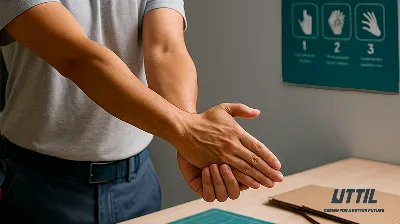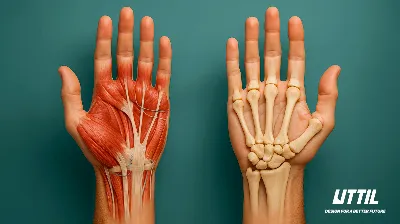Grip Atlas: Ergonomics and Controlled Cutting with UTTIL
Achieving the correct result when cutting is not only about selecting the right knife, but also about how it is used. The proper grip and angle contribute to working with less effort, cleaner lines and greater confidence.
This mini guide offers practical and easy-to-apply
ergonomic recommendations for everyday use within the UTTIL product
family.
1) Four basic grips: Which one when?
A. Pencil grip
When to use: For
short, controlled lines such as model details, template cuts, paper carving and
typography.
How does it feel? A
balanced grip guided by the thumb and index finger; control increases when the
wrist remains parallel to the line and in a natural position.
Examples from UTTIL: NMUK09
/ VMUK09 (HIPS body + TPE cover, finger rests) can provide a secure grip
for fine work. PTUK07 family, especially PTUK07-30 (9 mm, 30° tip), can
be preferred for precise cutting.
Examples from Mozart Blades: The Mozart Blades P1A and P1T
models, featuring a metal body, TPE coating, and finger support, provide a controlled
grip for fine work.
B. Power grip
Suitable for:
Long, steady cuts in corrugated cardboard, thick cardboard and Styrofoam-like
materials. It is necessary for cutting relatively hard or dense materials.
How does it feel?
When the body is gripped with the palm and moved forward at a narrow angle, line continuity is easier. Continuing the cut by increasing the cutting depth
in several passes gives a more controlled result. It is crucial for safety that
the blade is segmented and the single segment is open in this type of cutting. For cutting deep and thick materials with a power grip, it is recommended to use segmentless blades or trapezoidal blades that match the desired cutting depth.
Examples from UTTIL: VMUK09
(screw-lock) increases stability in long and deep lines with a segmentless
blade. NMUK04 / NMUK05 helps reduce pressure with its metal body weight.
PAUK06 features a trapezoidal blade, enabling plunge cutting and power
grip for both hands, and can be equipped with a hook blade if required.
Examples from Mozart Blades: Mozart
Blades S2 and EVO models offer the best results for power cutting
applications, such as thick floor coverings, thanks to their metal bodies,
weight, and ergonomic design.
C. Pinch grip
Suitable for:
Precise cuts requiring direction changes over short distances, manoeuvring in
tight spaces, and scraping cuts (e.g., when trimming leather material or
cleaning edge burrs).
How does it feel?
Movements of the wrist or elbow direct the balance established by pinching
between the thumb and index finger.
Examples from UTTIL: PTUK07
and PTUK08 family (pocket type, 9 and 18 mm) offer agile use in confined
spaces. The TPE surface on the NMUK09 can provide reliable grip even when hands are sweaty.
Examples from Mozart Blades: The Mozart Blades P2A and P2T models, featuring a flat metal body and TPE coating, provide a controlled and secure grip for tasks that require a pinch grip.
D. Trigger grip
Suitable for:
Rhythmic, serial cuts such as box dismantling, intensive packaging work and
warehouse operations, as well as cutting insulation materials, providing a firm
grip and cutting ability, especially with hook blades.
How does it feel?
Placing the index finger on the trigger protrusion under the body and
positioning the thumb on top of the body allows the body to be placed in the
palm, providing a strong and controlled cutting action. For safety, it is
imperative to ensure that the wrist remains straight, the flow is unobstructed, and your body is positioned outside the cutting line.
Examples from UTTIL: PAUK06
(trapezoidal blade, three-stage blade release) and PRUK06 (trapezoidal
blade, automatic retraction) are compatible with this grip, as both models have an architecture suitable for use with either the right or left hand.
2) Right/left hand and blade direction
- In
the PTUK07 family, the blade direction can be
changed, which helps to see the line more comfortably when working with
the left hand.
- PAUK06
/ PRUK06 body structure can be used equally with
both hands and is designed to maintain safe cutting, especially when
gripping the trigger.
- NMUK09
/ VMUK09 and other 18 mm bodies offer a natural
grip for the hand; features such as back teeth and TPE surfaces enhance
grip safety.
- Screw-tightened
(VMUK series) models provide the ability to adjust
blade stability and length, particularly when working on long or deep
cutting lines.
3) Gloves, wet surfaces and friction
- Use
of gloves: Nitrile or PU-coated gloves can
generally improve grip. Excessively slippery palm surfaces should be
avoided as they can reduce control.
- TPE's
contribution: UTTIL NMUK09 / VMUK09 or
Mozart Blades S2, P1, and P2 series feature a TPE coating that
increases the friction surface, providing a safer grip whether used with
gloves or on dry or slightly sweaty palms.
- Wetness:
Drying the handle and the hand that will grip the knife before cutting
helps improve cutting control.
4) Line management: ruler/guide and wrist
angle
- Scoring
(lightly scratching the surface): When the knife is
brought close to the surface at a slight angle of approximately 10–20°,
a smooth line can be achieved with a few light passes.
- Long
lines: A metal ruler and preferably a non-slip
base support line continuity. Securing the ruler and not directing the
blade towards the body during cutting reduces unwanted accidents.
- Corner
turns: Small, controlled movements of the
wrist, combined with a pinching grip, contribute to smoothness in turns.
5) Blade selection and practical maintenance
(with Mozart)
- Snap-off
blades: When the tip becomes blunt, breaking
off the segment safely helps maintain cutting quality. The break-off slot
in the steel clips of the PTUK07 and PTUK08 series makes this
process practical. For all other models, we recommend using pliers or a
similar tool to break off the blade segments for safety reasons. Never
force the tip to break uncontrollably, or attempt to break it by pressing
it firmly against a workbench or flat surface.
- Segment-free
(full) blade requirement: The VMUK series (screw-lock and single-piece blade models) is more suitable for deep and
smooth cuts.
- Trapezoidal
blades: The three-stage adjustable blade exit
in the PAUK06 allows for stage and control according to different
materials. The automatic retraction mechanism in the PRUK06 helps reduce
accidents at the end of the cut, enabling safer cutting.
- Mozart
Blades: All UTTIL models are compatible
with Solingen-made Mozart Blades, which offer 9 mm/18 mm snap-off,
30° precision tips, TiN coating and trapezoidal/hook options for clean
and continuous cuts.
6) Short safety summary
- Cutting
away from the body is generally safer.
- Closing
or locking the blade when the job is done can help reduce the risk of
accidents.
- Keeping
the work surface flat, dry, and non-slip enhances control.
- Collect
snap-off segments in a safe container. It is recommended to replace all
dull cutting tips with sharp ones as soon as possible.
The right UTTIL model, combined with the appropriate grip, can enhance the cutting experience by reducing effort, producing cleaner lines, and increasing confidence. Pen grip for precision, power grip for stability, pinch grip for manoeuvrability, and trigger grip strength in trapezoidal blade models; the ergonomics of UTTIL bodies and the cutting quality of Mozart Blades combine to deliver better results.








